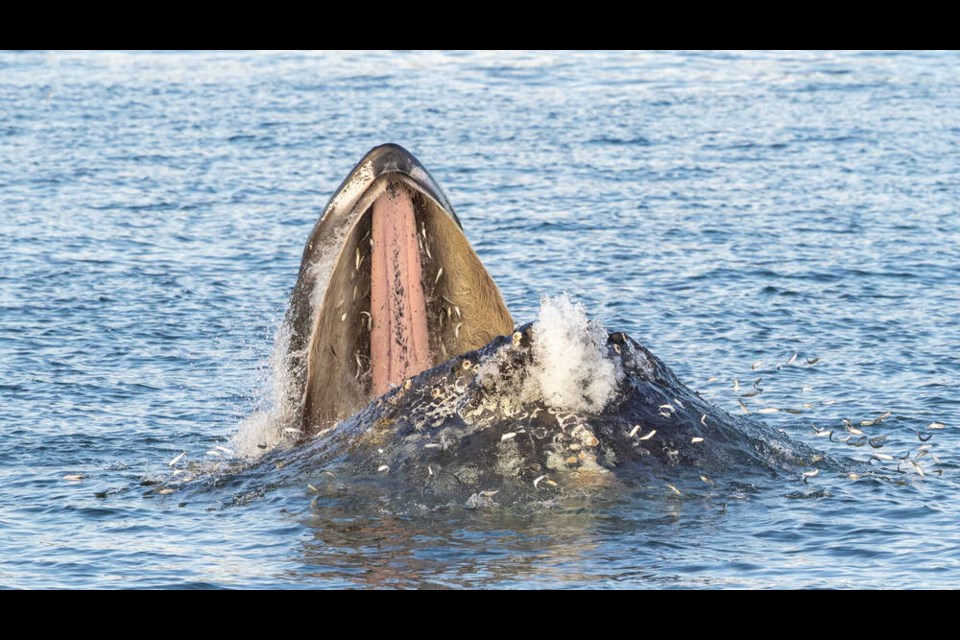Whale-watching companies and researchers on both sides of the border documented record numbers of Bigg’s orcas and humpbacks in the Salish Sea last year.
The Pacific Whale Watch Association, which has 16 member companies in the U.S. and 14 in Canada operating year round, recorded Bigg’s killer whales on 278 days and humpbacks on 274 days.
Gray whales were reported on 200 days and minke whales on 158 days during the year, according to the group’s year-end data released on Wednesday.
The Orca Behavior Institute, based in Friday Harbour, Washington, said there were 1,221 unique sightings of Bigg’s orcas in the Salish Sea in 2022 — 154 more than in 2021, which was a record, and double the number of sightings from five years ago.
A unique sighting is a sighting of a specific group of whales on a single day and does not include repeat reports of the same whales on the same day.
Last summer, the Pacific Whale Watch Association reported a single-day record with more than 70 Bigg’s killer whales in area waters from Hood Canal, Washington, to Campbell River.
Research group Bay Cetology, based in Alert Bay, said the coastal Bigg’s population continues to grow, with 370 individuals, including 10 new calves in 2022.
An ample supply of seals, the orcas’ main food source, is being credited for the growth.
The growing presence of Bigg’s orcas, also dubbed transient killer whales because they were seen infrequently decades ago, prompted the research and whale watching communities to name them for pioneering researcher Dr. Michael Bigg.
The Duncan-raised marine biologist, known as the founder of modern orca research, was hired as the head of marine-mammal research at the Department of Fisheries and Oceans’ Pacific Biological Station in Nanaimo and started the first transient census. Bigg died in 1990.
“When Bigg’s were first studied in the Salish Sea, it was just after the implementation of the [U.S.] Marine Mammal Protection Act [in 1972],” said Monika Wieland Shields, director and co-founder of the Orca Behavior Institute.
“In the decades since, seals, sea lions, and porpoises have all recovered in spectacular fashion. The Salish Sea can now support many more killer whales than it used to, and clearly word has spread.”
Humpback whales, meanwhile, continue their incredible comeback from near extinction after the whaling trade was shut down in the 1960s.
Researchers with the Canadian Pacific Humpback Collaboration announced last month that 396 individual humpback whales were photographed in the Salish Sea last year — the highest number documented in a single year since record-keeping started two decades ago.
The figure includes a record-breaking 34 mothers with calves who travelled from their tropical birthing grounds in Hawaii, Mexico, and Central America. The previous record of 21 humpback calves was set in 2021.
Erin Gless, executive director of the Pacific Whale Watch Association, also credits healthy food supplies. “Twenty years ago, it was rare to see humpbacks or Bigg’s killer whales in the Salish Sea. Now, we see them almost every day. It really demonstrates what’s possible if animals have an ample food supply,” she said.
But there is a sense of caution as the increasing numbers of humpbacks is raising the risk of ship strikes and entanglements.
Ship strikes are believed to have caused at least two of the five humpback deaths discovered on the North Island and Haida Gwaii in November.
And in December, a mature female humpback nicknamed Moon swam from the north coast of 小蓝视频 to the breeding grounds off Hawaii with a spine severely damaged in what’s believed to be a ship strike. The whale is emaciated from the 55-day journey and isn’t expected to return in the spring.
“The Salish Sea has become the whale equivalent of a busy school zone,” said Lisa Spaven of Fisheries and Oceans Canada’s Cetacean Monitoring and Research Project.
Spaven said monthly surveys show whales are present in all months throughout the region, making the Salish Sea an area of “considerable year-round overlap” between whales and commercial and recreational vessel traffic and fishing.
The Pacific Whale Watch Association also collects data on protective interventions by member companies during their tours. Examples include stopping other vessels from speeding near whales, alerting ferries, cargo ships or military vessels when whales are nearby, retrieving harmful debris such as old fishing gear and balloons, and reporting entangled or injured wildlife to proper authorities.
Last year, whale-watching captains, naturalists and crew members documented 1,066 such actions, the association said. In the 740 vessel-related actions, the association said it was successful in modifying the behavior of other nearby vessels in 74% of interactions.
The association also removed more than 300 pieces of marine debris and reported 20 injured or entangled whales and sea lions to local rescue teams.
The group also provided real-time whale sightings to emergency responders during the recovery of the sunken vessel Aleutian Isle near San Juan Island last summer.
Although whale-watching companies are prohibited from watching the endangered southern resident orcas — which are down to 73 animals in three pods — they’ve reportedly been seen in a super pod in Puget Sound in recent days.




